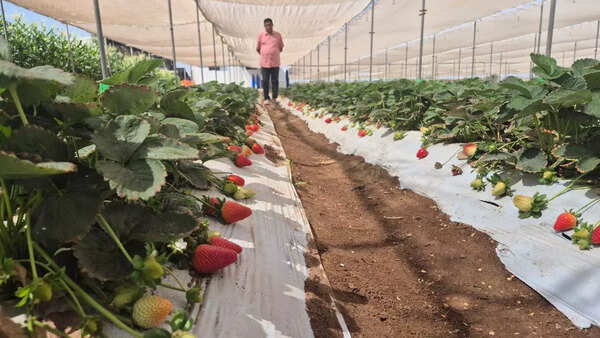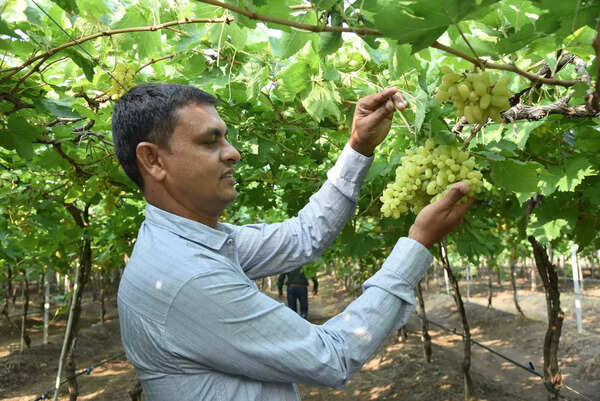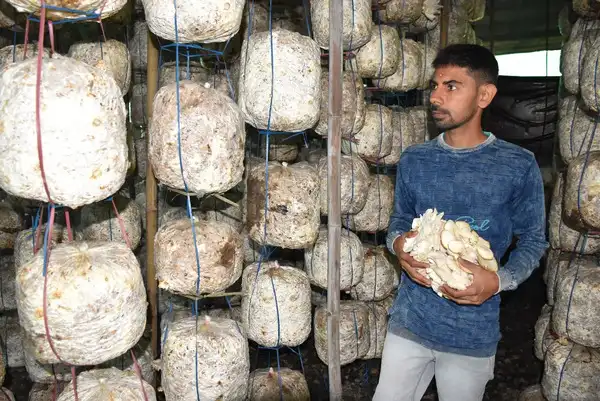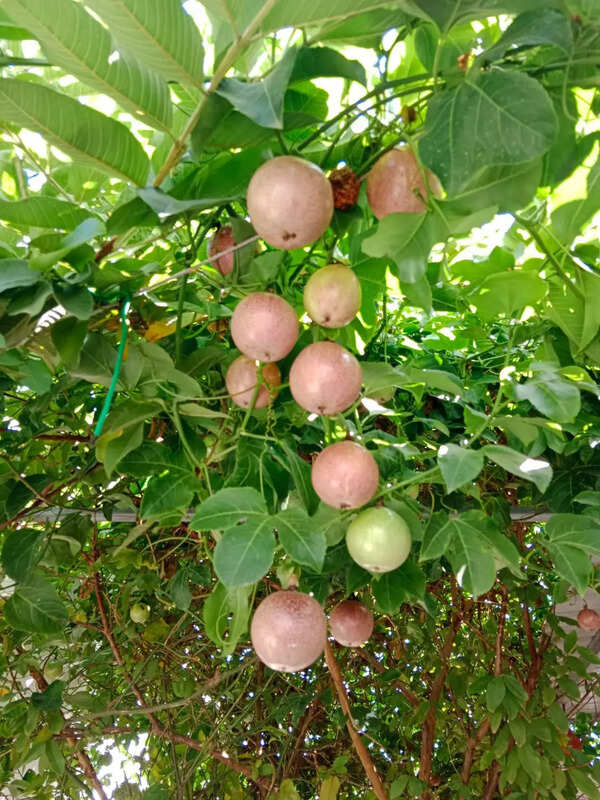ARTICLE AD BOX

Agricultural Innovation in Gujarat Has Shifted From Curiosity to Calculated Strategy. Farmers Across Multiple Districts Are Abandoning Conventional Crops for Audacious Alternatives — Avocados, Strawberries, Grapes — That Thrive in Arid Landscapes and Deliver Superior Returns
In the arid landscapes of Gujarat, where temperatures soar to 44°C, farmers are discovering that economic necessity breeds botanical innovation. What began as individual experiments — a chartered accountant growing avocados during lockdown, a graduate student cultivating mushrooms instead of seeking employment — has evolved into a pattern of agricultural diversification that challenges conventional wisdom about crop viability.The evidence lies in the yields. Haresh Thakkar harvests 400-800 grams per strawberry plant in Kutch, generating Rs 8-10 lakh annually from eight acres. Ishwar Patel’s grape production in Nakhatrana has grown from 10 tonnes to 80 tonnes over eight years in a region where grapes traditionally don’t grow. Amit Shah of Vaanch village near Ahmedabad nets Rs 8 lakh during a two-month phalsa season by processing fruit into pulp that sells for three times the fresh market price.

These success stories are indicators of a broader shift. H M Chavda, Gujarat’s director of horticulture, says the state govt is emphasizing horticulture promotion after progressive farmers successfully experimented with previously ungrown crops. “Farmers have been giving us feedback that horticulture crops provide much higher

returns than conventional crops,” he notes. The state govt has responded with subsidies — Rs 27,628 for fig cultivation, Rs 1 lakh for fruit processing units —recognizing that agricultural diversification may be both economically rational and climatically inevitable.
The question is no longer whether such crops can survive Gujarat’s harsh conditions, but whether the state’s agricultural economy can afford not to embrace them.
The lockdown avocados
When Viral Cheeda’s children kept asking for avocados during lockdown, the Mumbai chartered accountant did what any reasonable parent would do: he started growing them himself. Never mind that his farm was in Sherdi village, Kutch — one of India’s most unforgiving landscapes — or that avocados had never been commercially grown there.Three years later, Cheeda tends to 350-400 avocado trees, each standing 8-9 feet tall and promising his first substantial harvest. “Every crop needs special treatment like a newborn child,” explains Cheeda, whose innovative techniques include protecting trees with green netting to shield them from direct sunlight, using sprinkler irrigation rather than direct watering, and allowing seeds exposure to the atmosphere rather than burying them.

In Bhavnagar district, Danu Solanki from Kodiya village has achieved similar success with about 50 avocado plants sourced from a nursery. “I took care of this plant as I care for every plant, and that’s how I achieved success,” says Solanki, who also grows dragon fruit, dates and citrus varieties, demonstrating the diverse potential of the state’s evolving agricultural sector.
Desert strawberries
Haresh Thakkar from Reldi village near Bhuj has accomplished the extraordinary feat of growing strawberries in Kutch’s arid landscape.
Strawberries, typically cultivated in the hilly areas of Mahabaleshwar, Ooty and parts of Himachal Pradesh, Uttar Pradesh and northeastern India, are thriving under Thakkar’s care.With around 36,000 plants spread across eight acres, Thakkar harvests 400-800 grams per plant, generating an annual income of Rs 8-10 lakh. His secret lies in creating artificial microclimates using green netting and continuous water particle spraying via fogging machines to maintain cooling and humidity.“I maintain a maximum temperature of 28 degrees inside the net throughout the year,” he explains, acknowledging that while the initial investment in infrastructure is substantial, the returns make it worthwhile.
Kutch’s unlikely vineyard
Ishwar Patel of Rampar Roha village in Nakhatrana taluka of Kutch has been successfully cultivating grapes for eight years, despite the region’s climate differing significantly from traditional grape-growing areas like Maharashtra, Tamil Nadu, Andhra Pradesh and Karnataka.
His production has grown impressively from an initial 10 tonnes to 80 tonnes.

“Initially, I faced problems with undersized and damaged fruits, but I dedicated two years to research and analysis,” Patel says. “Through proper maintenance and consistent attention, I have been achieving satisfactory yields from my cultivation.”Patel maintained regular communication with five grape cultivators from Nashik, consulting them monthly regarding crop development.
He adjusted fertilizer doses and irrigation schedules to help the plants thrive in Kutch’s drier summers and colder winters.
The grad who chose fungi
MSc graduate Jatin Solanki chose agricultural entrepreneurship over conventional employment, establishing a mushroom cultivation business in Thanapipli village of Junagadh district. Since beginning in 2022, he now earns approximately Rs 10 lakh annually growing varieties including oyster mushroom, Lentinus sajor and grey oyster.

“While the crop cycle spans three months, maintaining cleanliness, temperature and humidity is absolutely critical,” explains Solanki. His operation has expanded from an initial 500 growing bags to 5,400 bags housed in specially designed tarpaulin domes supported by bamboo.Meanwhile, scientists at the Gujarat Institute of Desert Ecology (GUIDE) in Kutch have achieved a breakthrough with cordyceps militaris — a medicinal mushroom valued at Rs 1.5 lakh per kilogram.
The institute is developing multiple varieties of nutritious, protein-rich mushrooms while empowering rural communities through cultivation training, having already trained over 1,260 people from 10 states.
Brazilian fruit finds new home
Jayanti Gajera, a farmer from Bharudi in Gondal taluka, Rajkot district, has been experimenting with passion fruit for five years. Cultivating the Brazilian native on 1.5 acres, he produces around 6 tonnes annually while also processing fruit into pulp for frozen markets.
“I harvest around 6 tonnes every year and fetch a good market price,” Gajera explains. “I sell fresh fruit in the market and also make pulp from it.
There is an excellent market for frozen pulp, which I sell at fruit shops in Rajkot.”

The passion fruit season runs from June through the monsoon for six months. According to Gajera, this crop requires minimal special attention beyond the initial investment in canopy and poles.
The creeper grows up to eight feet and requires about 400 support poles per acre. Rich in vitamin C, potassium, iron and fibre, passion fruit benefits from increased consumer awareness of exotic fruits, particularly after Covid, with availability expanding from roadside vendors to quick commerce mobile apps.
Cotton farmer turns fig grower
Pravin Makwana from Khodu village, Surendranagar district, has cultivated conventional crops like cotton, sesame, pigeon pea, vegetables and cluster beans on 150 bighas for years.
Last year’s experiment with fig cultivation on one hectare of land has proven more profitable for him than conventional crops. Makwana did his homework first, researching online and consulting horticulture department officials.
The government provided a Rs 27,628 subsidy, which he used to procure 1,000 tissue culture fig saplings of the Diana variety from Hyderabad at Rs 85-100 per sapling.“With drip irrigation every 10 days and regular organic compost, the trees started bearing fruits after 11 months,” said Makwana.
“Selling figs is not challenging at all. Traders purchase directly from the farm. The price of figs ranges from Rs 900 to Rs 1,200 per kg,” he adds. He now plans to expand cultivation this year due to higher returns compared to vegetables like cluster beans and pigeon pea.
Phalsa: Cracker of a fruit venture
In Vaanch village on Ahmedabad’s outskirts, known for firecracker manufacturing, farmer Amit Shah has created a new identity through phalsa or Indian sherbet berry cultivation.
His venture generates approximately Rs 13 lakh seasonal income. “I earn a net profit of about Rs 8 lakh during the phalsa season, which lasts for one or two months,” says the 35-year-old farmer. “While phalsa sells for about Rs 150 per kg, when processed into pulp, it fetches three times the price.”With a Rs 1 lakh govt subsidy, Shah established a processing unit selling fruit pulp. He cultivates phalsa alongside papaya and amla over 5 bighas.
The phalsa season lasts just one to two months from April. “This year I plan to sell 3,000 kg of phalsa in the market and process the remaining 3,000 kg into pulp,” he says.
Academic caution amid innovation
While farmers celebrate their successes, agricultural institutions maintain a cautious stance. D K Varu, principal and dean of the College of Horticulture affiliated with Junagadh Agriculture University (JAU), emphasizes the need for systematic evaluation.“Many farmers have experimented with diversified crops, but currently we do not know whether our weather and soil conditions are truly conducive for them,” Varu says. “We only consider a crop successful when it becomes economically viable and profitable for farmers.” However, he acknowledges the pioneering spirit: “If progressive farmers want to experiment, they may allocate a small portion of their farmland to these diversified crops on an experimental basis.” While academics call for more research, farmers are already expanding their plots. Time will tell whether Gujarat’s agricultural rebels can sustain their success at scale. But for now, the desert is blooming with crops that were never supposed to grow there.— With inputs from Meghdoot Sharon



.png)
.png)
.png)
















 4 hours ago
5
4 hours ago
5









 English (US) ·
English (US) ·